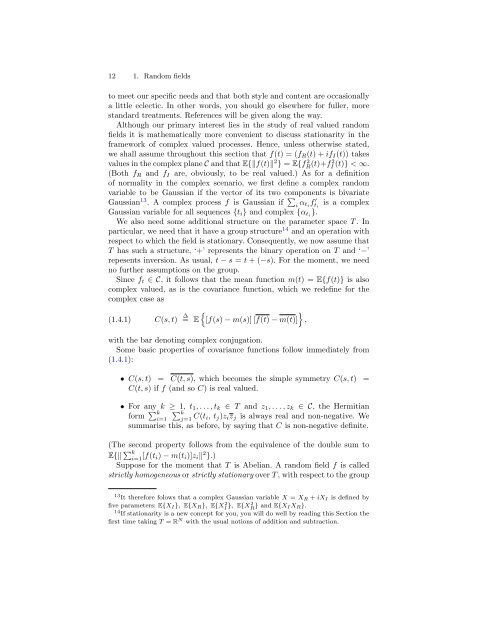You also want an ePaper? Increase the reach of your titles
YUMPU automatically turns print PDFs into web optimized ePapers that Google loves.
12 1. Random fields<br />
to meet our specific needs and that both style and content are occasionally<br />
a little eclectic. In other words, you should go elsewhere for fuller, more<br />
standard treatments. References will be given along the way.<br />
Although our primary interest lies in the study of real valued random<br />
fields it is mathematically more convenient to discuss stationarity in the<br />
framework of complex valued processes. Hence, unless otherwise stated,<br />
we shall assume throughout this section that f(t) = (fR(t) + ifI(t)) takes<br />
values in the complex plane C and that E{�f(t)� 2 } = E{f 2 R (t)+f 2 I<br />
(t)} < ∞.<br />
(Both fR and fI are, obviously, to be real valued.) As for a definition<br />
of normality in the complex scenario, we first define a complex random<br />
variable to be Gaussian if the vector of its two components is bivariate<br />
Gaussian13 . A complex process f is Gaussian if �<br />
i αtif ′ ti is a complex<br />
Gaussian variable for all sequences {ti} and complex {αti }.<br />
We also need some additional structure on the parameter space T . In<br />
particular, we need that it have a group structure14 and an operation with<br />
respect to which the field is stationary. Consequently, we now assume that<br />
T has such a structure, ‘+’ represents the binary operation on T and ‘−’<br />
repesents inversion. As usual, t − s = t + (−s). For the moment, we need<br />
no further assumptions on the group.<br />
Since ft ∈ C, it follows that the mean function m(t) = E{f(t)} is also<br />
complex valued, as is the covariance function, which we redefine for the<br />
complex case as<br />
(1.4.1)<br />
C(s, t) ∆ �<br />
�<br />
= E [f(s) − m(s)] [f(t) − m(t)] ,<br />
with the bar denoting complex conjugation.<br />
Some basic properties of covariance functions follow immediately from<br />
(1.4.1):<br />
• C(s, t) = C(t, s), which becomes the simple symmetry C(s, t) =<br />
C(t, s) if f (and so C) is real valued.<br />
• For any k ≥ 1, t1, . . . , tk ∈ T and z1, . . . , zk ∈ C, the Hermitian<br />
form �k �k i=1 j=1 C(ti, tj)zizj is always real and non-negative. We<br />
summarise this, as before, by saying that C is non-negative definite.<br />
(The second property follows from the equivalence of the double sum to<br />
E{� �k i=1 [f(ti) − m(ti)]zi�2 }.)<br />
Suppose for the moment that T is Abelian. A random field f is called<br />
strictly homogeneous or strictly stationary over T , with respect to the group<br />
13It therefore folows that a complex Gaussian variable X = XR + iXI is defined by<br />
five parameters: E{XI}, E{XR}, E{X2 I }, E{X2 R } and E{XIXR}.<br />
14If stationarity is a new concept for you, you will do well by reading this Section the<br />
first time taking T = RN with the usual notions of addition and subtraction.
















